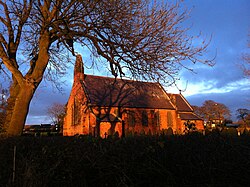Shevington
| Shevington | |
| Lancashire | |
|---|---|
 St Anne's Church in Shevington | |
| Location | |
| Grid reference: | SD542086 |
| Location: | 53°34’19"N, 2°41’24"W |
| Data | |
| Population: | 10,000 (2013 est.) |
| Post town: | Wigan |
| Postcode: | WN6 |
| Dialling code: | 01257 |
| Local Government | |
| Council: | Wigan |
| Parliamentary constituency: |
Wigan |
Shevington is a village in Lancashire, sitting some three miles to the north-west of Wigan town centre, and three and half miles from Skelmersdale. At the 2001 census the village had a recorded population of 9,786.
Shevington consists of a mixture of private and council housing, predominantly centred on two rows of shops in the centre of the village. Shevington has two pharmacies, two newsagents, a post office, a small supermarket, two bakers' shops, a carpet shop, a fish and chip shop, an estate agent, two hairdressers, a hardware store, three takeaways, a Conservative club and a public house. There is also a clinic, a doctors' surgery and a library.
Shevington also has a public park, containing a war memorial to those lost during the 20th century's both World Wars.
Geography
Shevington is built on sloping land between Standish and Wigan to the north-east of the River Douglas. The underlying rocks are coal measures.
The Leeds and Liverpool Canal runs parallel to the River Douglas. Shevington is located close to Junction 27 of the M6 motorway and is bordered by the villages of Appley Bridge and Standish, but also has close links to the villages of Wrightington and Standish Lower Ground.
Today there is little evidence of past industrial activity though there has been a marked increase in residential development between the 1950s and 1980s attracted by Shevington's pleasant rural setting, still surrounded by much open land and ancient woods. Further residential development, on the former Orica site to the south of the village, is currently underway with an expected completion date of late 2012. The 2001 census recorded a population of 11,725 in the Shevington with Lower Ground ward.
Name
The name of Shevington is of uncertain origin, but it is commonly said to come from that of a hill called shevin, derived from the Celtic cevn (the modern Welsh cefn) meaning a ridge, with the Old English tun, a farmstead. It is a hill slope settlement in the Douglas Valley recorded in documents in 1225 as Shefington.[1] Other recorded spellings include Scheuynton in 1253, Sheuington in 1277, Sewinton 1288 and Sheuynton in 1292.[2]
History
Shevington became a manor, an estate system of local government held of the king by a Lord of the Manor from the 12th to the 18th centuries. The area was included within the ecclesiastical parish of Standish until 1887 when it was granted separate status with the consecration of St Anne's Church.
From earliest times the area had a sparse and scattered population eking out a living from the common and wood and farmlands owned by the church including Burscough Priory, Cockersand Abbey and the Knights Hospitallers until the Dissolution of the Monasteries from 1536 and that of the local gentry included Sir Adam Banastre, Lord of the Manor in 1288 and the Standish, Catterall, Stanley, Rigby, Hulton, Dicconson and Hesketh families – the last being the last Lord of the Manor in 1798.[2]
By the 18th century most of the common land had been enclosed forming landed estates and tenant farms where mixed farming was practised. Corn was ground into flour at local water mills – Finch Mill on the Calico Brook and Standish Mill on Mill Brook and skills associated with agriculture developed, such as smithies and wheelwrights. Handloom weaving and basket making were also undertaken together with primitive coal mining in the Elnup Woods area.
Demand for coal mining during the Industrial Revolution led to an intensification of mining with coal from many local pits transported by way of the River Douglas at Gathurst when the river was made navigable in 1742 but replaced from the 1780s by the Leeds and Liverpool Canal when much of the coal was loaded on to barges at Crooke.
Past industries have included a glue factory and brick and tile works in Appley Bridge and the Roburite Explosives Works (now Orica) at Gathurst from 1941/42 which employed over 500 workers during Second World War, but was first established south of the River Douglas in 1888.
Shevington's scattered communities became more cohesive with the development of the village school from 1814, residential development from the 1850s the original Plough & Harrow public house, post office and shops near or in the long-recognised centre of the village at Broad o' th' Lane.
Churches
- Church of England: St. Anne's Church.[3]
- Methodist: Shevington Methodist Church
- Roman Catholic: St. Bernadette's
Sport
- Golf: Gathurst Golf Club
- Rugby league: Shevington Sharks
Outside links
| ("Wikimedia Commons" has material about Shevington) |
References
- ↑ Mills 1998, p. 310
- ↑ 2.0 2.1 A History of the County of Lancaster - Volume pp 199–203: {{{2}}} (Victoria County History); [1]
- ↑ Shevington St Anne
- Mills, A.D. (1998), Dictionary of English Place-Names, Oxford
